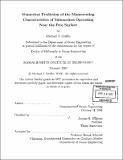| dc.contributor.advisor | Jerome H. Milgram. | en_US |
| dc.contributor.author | Griffin, Michael James | en_US |
| dc.contributor.other | Massachusetts Institute of Technology. Dept. of Ocean Engineering. | en_US |
| dc.date.accessioned | 2005-08-23T19:13:21Z | |
| dc.date.available | 2005-08-23T19:13:21Z | |
| dc.date.copyright | 2002 | en_US |
| dc.date.issued | 2002 | en_US |
| dc.identifier.uri | http://hdl.handle.net/1721.1/8327 | |
| dc.description | Thesis (Ph. D.)--Massachusetts Institute of Technology, Dept. of Ocean Engineering, 2002. | en_US |
| dc.description | Includes bibliographical references (leaves 133-136). | en_US |
| dc.description.abstract | A method for coupling a Reynolds-averaged Navier-Stokes (RANS) computer code with an inviscid panel code to predict the maneuvering characteristics of submarines operating near the free-surface has been developed. The RANS code calculates the flow field immediately surrounding and in the wake of the body where viscous effects are important. The panel code calculates the fluid flow in the far field including the free-surface where viscous effects are negligible. The computational domains used by each code overlap, and it is this overlap that enables their coupling. The evolution of the free-surface boundary condition is linked to the evolution of the bulk flow through a novel iteration technique that first computes the viscous flow near and in the wake of the body, and then computes the potential flow outside the viscous region including at the free-surface. Calculated and measured vertical force and pitching moment are in excellent agreement for conditions where free-surface effects are minimal. In addition calculated vertical plane maneuvering coefficients are presented. There is no known experimental force and moment data available for submarine bodies where free-surface effects are significant, and therefore only qualitative statements pertaining to validation of the method can be made under such conditions. Five submarine geometries operating at five depths, seven Froude numbers and several pitch angles have been simulated to obtain relationships between these parameters and the vertical force and pitching moment on the bodies. Iterative and grid convergence have been demonstrated. | en_US |
| dc.description.statementofresponsibility | by Michael J. Griffin. | en_US |
| dc.format.extent | 136 leaves | en_US |
| dc.format.extent | 14154693 bytes | |
| dc.format.extent | 14154449 bytes | |
| dc.format.mimetype | application/pdf | |
| dc.format.mimetype | application/pdf | |
| dc.language.iso | eng | en_US |
| dc.publisher | Massachusetts Institute of Technology | en_US |
| dc.rights | M.I.T. theses are protected by copyright. They may be viewed from this source for any purpose, but reproduction or distribution in any format is prohibited without written permission. See provided URL for inquiries about permission. | en_US |
| dc.rights.uri | http://dspace.mit.edu/handle/1721.1/7582 | |
| dc.subject | Ocean Engineering. | en_US |
| dc.title | Numerical prediction of the maneuvering characteristics of submarines operating near the free surface | en_US |
| dc.type | Thesis | en_US |
| dc.description.degree | Ph.D. | en_US |
| dc.contributor.department | Massachusetts Institute of Technology. Department of Ocean Engineering | |
| dc.identifier.oclc | 50498979 | en_US |
